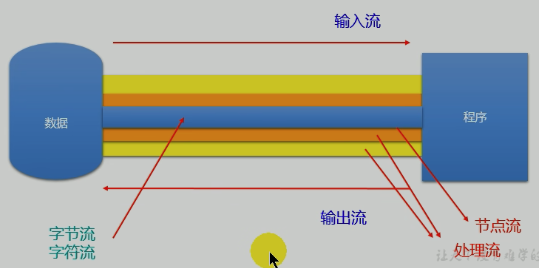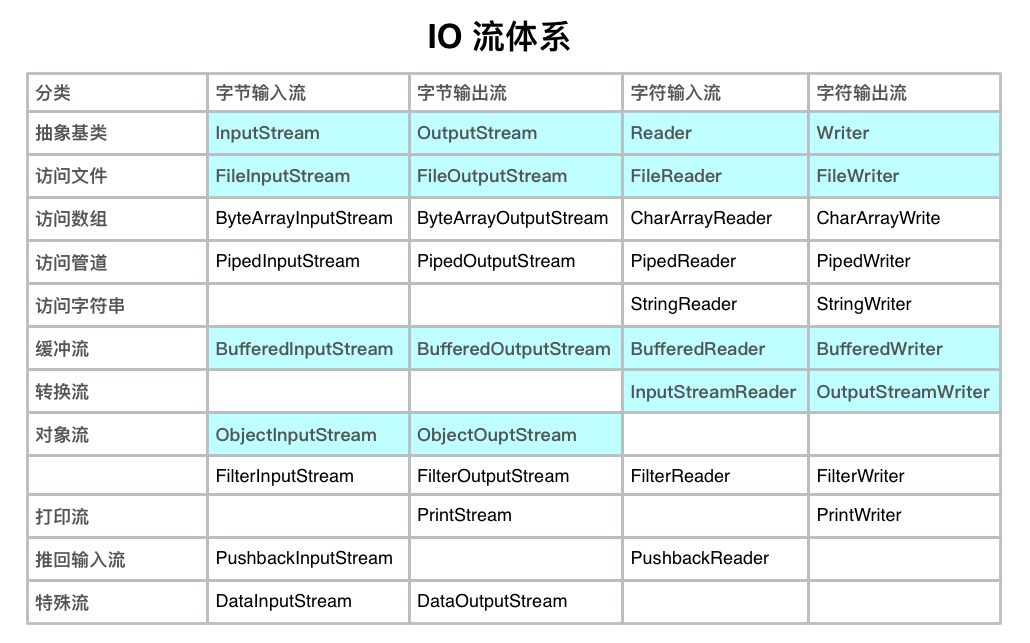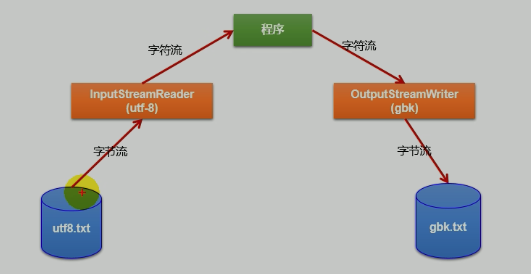javaSE基础-IO流
IO流
File类
基本概念
File类的一个对象,代表一个文件或一个文件目录(俗称文件夹)
File类声明在java.io包下
File类中涉及到关于文件或文件目录的创建、删除、重命名、修改时间、文件大小等方法并未涉及到写入或读取文件内容的操作。如果需要读取或写入文件内容,必须使用IO流来完成
File类的对象常会作为参数传递到流的构造器中,指明读入或写出的"终点"
构造器使用
File(String pathname):指定路径名的字符串转换成一个抽象路径名
File(String parent, String child):指定父路径的字符串和子路径的字符串
File(File parent, String child):指定父路径的抽象路径名和子路径的字符串
示例:
@Test
public void test1(){
//构造器1:
File file1 = new File("hello.txt");
File file2 = new File("/Users/jbb/java_project/pro01/hah.txt");
//构造器2:
File file3 = new File("/Users/jbb/java_project", "pro01");
File file4 = new File("/User" + File.separator + "jbb");
//构造器3:
File file5 = new File(file3, "name.txt");
System.out.println(file1);// hello.txt
System.out.println(file2);// /Users/jbb/java_project/pro01/hah.txt
System.out.println(file3);// /Users/jbb/java_project/pro01
System.out.println(file4);// /User/jbb
System.out.println(file5);// /Users/jbb/java_project/pro01/name.txt
}
路径分类
相对路径:相较于某个路径下,指明的路径
绝对路径:包含盘符在内的文件或文件目录的路径
相对路径的说明
idea中:使用JUint中的单元测试方法,相对路径为当前Module下。在main()测试中,相对路径为当前的Project下
Eclipse中:单元测试和main()测试,相对路径都是Project下
路径分割符:File.separator
在windows:\
在unix:/
常用方法
文件基本属性获取
public String getAbsolutePath(): 获取绝对路径
public String getPath(): 获取路径
public String getName(): 获取名称
public String getParent(): 获取上层文件目录路径,若无返回null
public String Length(): 获取文件长度(即字节),不能获取目录的长度
public String LastModified(): 获取最后一次的修改时间,毫秒值
文件遍历
public String[] list(): 获取指定目录下的所有文件或者文件目录的名称数组
public File[] listFiles(): 获取指定目录下的所有文件或者文件目录的File数组
@Test
public void test2(){
File file1 = new File("./");
File file2 = new File("/Users/jbb/java_project/pro01");
System.out.println(file1.getAbsoluteFile());
System.out.println(file1.getPath());
System.out.println(file1.getName());
System.out.println(file1.getParent());
System.out.println(file1.length());
System.out.println(new Date(file1.lastModified()));
//遍历文件夹路径下文件-->输出文件的名
String[] list = file1.list();
for (String s : list) {
System.out.println(s);
}
//遍历文件夹路径下文件-->输出完整的文件路径+文件名
File[] files = file2.listFiles();
for (File file : files) {
System.out.println(file);
}
}
文件重命名并移动
public boolean renameTo(File dest): 把文件重命名为指定的文件路径下
@Test
public void test3(){
File file1 = new File("./hi2.txt");
File file2 = new File("/Users/jbb/Documents/javaTest/hello2.txt");
boolean renameTo = file1.renameTo(file2);
System.out.println(renameTo);// 返回true表示操作成功,false表示失败
}
注:file1.renameTo(file2)为例:file1必须存在,file2不能存在(移动成功后file1不存在)
文件功能判断
public boolean isDirectory():判断是否是文件目录
public boolean isFile():判断是否是文件
public boolean exists():判断是否存在
public boolean canRead():判断是否可读
public boolean canWrite():判断是否可写
public boolean isHidden():判断是否是隐藏
@Test
public void test4(){
File file1 = new File("./hi.txt");
System.out.println(file1.isDirectory());
System.out.println(file1.isFile());
System.out.println(file1.exists());
System.out.println(file1.canRead());
System.out.println(file1.canWrite());
System.out.println(file1.isHidden());
}
创建硬盘中对应的文件或文件目录
public boolean createNewFile(): 创建文件,若文件存在,则不创建,返回false
public boolean mkdir(): 创建文件目录,如果此文件目录存在就不创建了,如果此文件目录的上层目录不存在也不创建
public boolean mkdirs(): 创建文件目录,如果上层目录不存在,一并创建。
删除功能
public boolean delete(): 删除文件或者文件夹(此删除不走回收站)
@Test
public void test5() throws IOException {
File file1 = new File("./hi.txt");
if(!file1.exists()){
file1.createNewFile();
System.out.println("创建成功");
}else {
file1.delete();
System.out.println("删除成功!");
}
}
@Test
public void test6() throws IOException {
//上一层目录不存在无法创建成功
File file1 = new File("/Users/jbb/Documents/javaTest/IO2/io3");
boolean mkdir = file1.mkdir();
if (mkdir){
System.out.println("mkdir 创建成功1");
}
//无论上一层目录是否存在,都会创建成功
File file2 = new File("/Users/jbb/Documents/javaTest/IO2/io4");
boolean mkdirs = file2.mkdirs();
if(mkdirs){
System.out.println("mkdirs 创建成功2");
}
}
IO流原理及流的分类
流的分类
- 按操作数据单位不同分为:字节流(8bit)、字符流(16bit)
- 按数据流的流向(按程序的角度)不同分为:输入流、输出流
- 按流的角色的不同分为:节点流、处理流
分类示意图:

IO流体系结构

常用的流

节点流(文件流)
FileReader 和 FileWrite
读取文件内容到控制台中
@Test
public void testFileReader2() {
FileReader fr = null;
try {
//1、获取读取文件
File file = new File("hello.txt");
//2、指定具体流
fr = new FileReader(file);
//3、读入的过程(使用char[]优化方式)
char[] cbuf = new char[5];
int len;
while((len= fr.read(cbuf)) != -1){
//方式一:
//读取文件出错
//for (int i = 0; i < cbuf.length; i++) {
// System.out.print(cbuf[i]);
//}
//for (int i = 0; i < len; i++) {
// System.out.print(cbuf[i]);
//}
//方式二
//读取文件出错
//String str = new String(cbuf);
//表示每次写满cbuf的长度,最后没有满则逐个添加字符
String str = new String(cbuf, 0, len);
System.out.print(str);
}
} catch (IOException e) {
throw new RuntimeException(e);
} finally {
//4、关闭资源
if(fr != null) {
try {
fr.close();
} catch (IOException e) {
throw new RuntimeException(e);
}
}
}
}
说明:
1、read():返回读入的每一个字符,如果达到文件末尾,返回-1
2、异常处理:为保证流资源一定可以执行关闭操作,需要try-catch-finally处理
3、读入的文件一定要存在,否在就会报FileNotFoundException
文件写出到新的文件
@Test
public void testFileWrite() {
FileWriter fr = null;
try {
//指明操作的文件
File file = new File("hello1.txt");
//确定具体的流
fr = new FileWriter(file, true);
//向文件写入内容
fr.write("I'm a working\n");
fr.write("It's very intersting");
} catch (IOException e) {
throw new RuntimeException(e);
} finally {
if(fr != null){
//资源关闭
try {
fr.close();
} catch (IOException e) {
throw new RuntimeException(e);
}
}
}
}
说明:
1、输出操作,对应的File可以不存在,并不会报错
2、File对应的硬盘中的文件如果不存在,在输出的过程中,会自动创建此文件
File对应的硬盘中的文件如果存在:
构造器:FileWriter(file, false) / FileWriter(file):就会对原文件进行覆盖
构造器:FileWriter(file, true):不会对原文件覆盖,而是在原文件的基础上追加内容
文件的读入写出操作,从scrFile完整复制到destFile
@Test
public void testFileReaderWrite() {
FileReader fr = null;
FileWriter fw = null;
try {
//操作的文件
File srcFile = new File("hello.txt");
File destFile = new File("hello2.txt");
//具体的流操作
fr = new FileReader(srcFile);
fw = new FileWriter(destFile);
//读入、写出操作
char[] cbuf = new char[5];
int len;
//读取到char数组的字符的个数
while ((len = fr.read(cbuf)) != -1){
fw.write(cbuf, 0, len);
}
} catch (IOException e) {
throw new RuntimeException(e);
} finally {
//资源关闭
try {
if(fw != null)
fw.close();
} catch (IOException e) {
throw new RuntimeException(e);
}
try {
if (fr != null)
fr.close();
} catch (IOException e) {
throw new RuntimeException(e);
}
}
}
FileInputStream 和 FileOutputStream
使用字节流读入文本文件
@Test
public void FileInputStreamTest() {
FileInputStream fis = null;
try {
//造文件
File file = new File("hello.txt");
//造流
fis = new FileInputStream(file);
//读入操作-->byte数组保存char字符,容易出乱码
byte[] buffer = new byte[5];
int len;
while((len = fis.read(buffer)) != -1){
String str = new String(buffer, 0, len);
System.out.print(str);
}
} catch (IOException e) {
throw new RuntimeException(e);
} finally {
if(fis != null){
//资源关闭
try {
fis.close();
} catch (IOException e) {
throw new RuntimeException(e);
}
}
}
}
注:使用字节流处理文本文件可能会出现乱码
使用字节流处理非文本文件:复制图片
@Test
public void FileInputOutStreamTest() {
FileInputStream fis = null;
FileOutputStream fos = null;
try {
File scrFile = new File("omnigraffle1.png");//源文件
File destFile = new File("omnigraffle2.png");//目标文件
fis = new FileInputStream(scrFile);
fos = new FileOutputStream(destFile);
byte[] buffer = new byte[5];
int len;
while((len = fis.read(buffer)) != -1){
fos.write(buffer, 0, len);
}
System.out.println("复制成功");
} catch (IOException e) {
throw new RuntimeException(e);
} finally {
if(fos != null){
try {
fos.close();
} catch (IOException e) {
throw new RuntimeException(e);
}
}
if(fis != null){
try {
fis.close();
} catch (IOException e) {
throw new RuntimeException(e);
}
}
}
}
结论:
1、对于文本文件(.txt, .java, .c, .cpp ...),建议使用字符流处理(FileReader 和 FileWrite)
2、对于非文本文件(.jpg, .mp3, .mp4, .doc, .pdf),使用字节流处理(FileInputStream 和 FileOutputStream)
缓冲流(处理流之一)
作用:提供流的读入、写出操作,提高读写速度,原因是提供了一个缓冲区
private static int DEFAULT_BUFFER_SIZE = 8192;
BufferedInputStream 和 BufferedOutputStream
字节流的处理流:实现文件复制
@Test
public void testBufferedByte(){
FileInputStream fis = null;
FileOutputStream fos = null;
BufferedInputStream bis = null;
BufferedOutputStream bos = null;
try {
//造文件
File srcFile = new File("hello.txt");
File destFile = new File("hello4.txt");
//造流
//文件流
fis = new FileInputStream(srcFile);
fos = new FileOutputStream(destFile);
//缓冲流
bis = new BufferedInputStream(fis);
bos = new BufferedOutputStream(fos);
//复制过程实现-->字节读入到写出,不存在显式地打印输出,不会出现乱码问题
byte[] buffer = new byte[5];
int len;
while((len = bis.read(buffer)) != -1){
bos.write(buffer, 0 ,len);
//刷新缓冲区
bos.flush();
}
System.out.println("复制成功");
} catch (IOException e) {
throw new RuntimeException(e);
} finally {
if(bos != null){
//关闭资源
try {
bos.close();
} catch (IOException e) {
throw new RuntimeException(e);
}
}
if(bis != null){
try {
bis.close();
} catch (IOException e) {
throw new RuntimeException(e);
}
}
//注:外层缓冲流关闭,内层字节流自动关闭
//fos.close();
//fis.close();
}
}
BufferedReader 和 BufferedWrite
字符流的处理流:实现文本文件的复制
@Test
public void testBufferedChar(){
BufferedReader br = null;
BufferedWriter bw = null;
try {
//指定文件和造流
br = new BufferedReader(new FileReader(new File("hi.txt")));
bw = new BufferedWriter(new FileWriter(new File("hi2.txt")));
//文件复制过程
//方式一:按每个char[] 读取
//char[] cbuf = new char[10];
//int len;
//while((len = br.read(cbuf)) != -1){
// bw.write(cbuf, 0 ,len);
// bw.flush();
//}
//方式二:按每一行读取
String data;
while((data = br.readLine()) != null){
//写出+换行
//方法一:
//bw.write(data + "\n");
//方法二:
bw.write(data);
bw.newLine();//写完一行,新换一行
bw.flush();
}
System.out.println("复制成功。");
} catch (IOException e) {
throw new RuntimeException(e);
} finally {
if(bw != null){
//关闭资源
try {
bw.close();
} catch (IOException e) {
throw new RuntimeException(e);
}
}
if(br != null){
try {
br.close();
} catch (IOException e) {
throw new RuntimeException(e);
}
}
}
}
案例:词频统计,读一个文本文件内容,统计每个字符到一个文件中
//CountWord.java
public class CountWord {
public static void main(String[] args) {
FileReader fr = null;
BufferedWriter bw = null;
try {
//map集合临时存储 “字符 = 数量”
HashMap<Character, Integer> map = new HashMap<>();
fr = new FileReader(new File("hi.txt"));
bw = new BufferedWriter(new FileWriter(new File("hi_countWord.txt")));
char[] cbuf = new char[5];
int data;
while((data = fr.read(cbuf)) != -1) {
for (int i = 0; i < data; i++) {
char ch = (char) cbuf[i];
if (map.get(ch) == null) {
map.put(ch, 1);
} else {
map.put(ch, map.get(ch) + 1);
}
}
}
//将map集合中的键值对写出到文件中
Set<Map.Entry<Character, Integer>> entries = map.entrySet();
for( Map.Entry<Character, Integer> entry: entries ) {
//匹配key的值
switch (entry.getKey()) {
case ' ':
bw.write("空格=" + entry.getValue());
break;
case '\n':
bw.write("换行=" + entry.getValue());
break;
case '\t':
bw.write("制表符=" + entry.getValue());
break;
case '\r':
bw.write("回车=" + entry.getValue());
break;
default:
bw.write(entry.getKey() + "=" + entry.getValue());
break;
}
bw.newLine();//每写出一次,换行
}
} catch (IOException e) {
throw new RuntimeException(e);
} finally {
if (bw != null){
try {
bw.close();
} catch (IOException e) {
throw new RuntimeException(e);
}
}
if(fr != null){
try {
fr.close();
} catch (IOException e) {
throw new RuntimeException(e);
}
}
}
}
}
转换流(处理流之二)
转换流:属于字符流
InputStreamReader:将一个字节的输入流转换为字符的输入流
OutputStreamWriter:将一个字符输出流转换为字节的输出流
作用:提供字节流与字符流之间的转换
转换流实现示意图

实现字节的输入流到字符的输入流的转换:InputStreamReader
@Test
public void test1() throws IOException {
File file = new File("hello.txt");
FileInputStream fis = new FileInputStream(file);
//使用系统默认的字符集
//InputStreamReader isr = new InputStreamReader(fis);
//参数2指定字符集-->根据文件保存时的字符集
InputStreamReader isr = new InputStreamReader(fis, "utf-8");
char[] cbuf = new char[5];
int len;
while((len = isr.read(cbuf)) != -1){
String str = new String(cbuf, 0, len);
System.out.print(str);
}
isr.close();
fis.close();
}
综合使用:InputStreamReader、OutputStreamWriter
@Test
public void test2() throws IOException {
File file1 = new File("hello.txt");
File file2 = new File("hello_gbk.txt");
FileInputStream fis = new FileInputStream(file1);
FileOutputStream fos = new FileOutputStream(file2);
InputStreamReader isr = new InputStreamReader(fis, "utf-8");
OutputStreamWriter osw = new OutputStreamWriter(fos, "gbk");
char[] cbuf = new char[5];
int len;
while((len = isr.read(cbuf)) != -1){
osw.write(cbuf, 0, len);
osw.flush();
}
osw.close();
isr.close();
}
解码:字节、字节数组 --> 字符数组、字符串
编码:字符数组、字符串 --> 字节、字节数组
字符集:
ASCII:美国标准信息交换码,用一个字节的7位可以表示
ISO8859-1:拉丁码表、欧洲码表,用一个字节的8位表示
GB2312:中国的中文编码表,最多两个字节编码所有字符
GBK:中国的中文编码表升级版,融合更多的中文文字字符号,最多两个字节编码
Unicode:国际标准码,融合了目前人类使用的所有字符。为每个字符分配唯一的字符码。所有的文字都用两个字节来表示
UTF-8:变长的编码方式,可用1-4个字节来表示一个字符
标准输入、输出流
System.in:标准的输入流,默认从键盘输入
System.out:标准的输出流,默认从控制台输出
方法:setIn(InputStream is) / setOut(PrintStream ps):重新指定输入和输出的流
示例一:
/**
* 从键盘输入字符串,要求将读取到的整行字符串转换成大写输出。然后继续进行输入操作,
* 直到当输入"e" 或者 "exit"时,退出程序
*
* 方法一:使用Scanner实现,调用next()返回一个字符串
* 方式二:使用System.in实现, System.in --> 转换流 --> BufferedReader的readLine()
*/
@Test
public void test1(){
BufferedReader br = null;
try {
InputStreamReader isr = new InputStreamReader(System.in);
br = new BufferedReader(isr);
while (true){
System.out.println("请输入字符串:");
String line = br.readLine();
if("e".equalsIgnoreCase(line) || "exit".equalsIgnoreCase(line)){
System.out.println("程序结束");
break;
}
String toUpperCase = line.toUpperCase();
System.out.println(toUpperCase);
}
} catch (IOException e) {
throw new RuntimeException(e);
} finally {
if(br != null){
try {
br.close();
} catch (IOException e) {
throw new RuntimeException(e);
}
}
}
}
示例二:从控制台输入字符串转换基本的数据类型(byte、short、boolean、float、double、int)
//MyInput.java
public class MyInput {
public static String readStr() {
BufferedReader br = new BufferedReader(new InputStreamReader(System.in));
String str = "";
try {
str = br.readLine();
} catch (IOException e) {
System.out.println(e);
}
return str;
}
public static byte nextByte(){
return Byte.parseByte(readStr());
}
public static short nextShort(){
return Short.parseShort(readStr());
}
public static boolean nextBoolean(){
return Boolean.parseBoolean(readStr());
}
public static float nextFloat(){
return Float.parseFloat(readStr());
}
public static double nextDouble(){
return Double.parseDouble(readStr());
}
public static int nextInt(){
return Integer.parseInt(readStr());
}
}
打印流
PrintStream 和 PrintWriter
@Test
public void test3() {
PrintStream ps = null;
try {
FileOutputStream fos = new FileOutputStream(new File("ASCII_char.txt"));
//创建打印输出流,设置为自动刷新模式
ps = new PrintStream(fos, true);
if(ps != null){
//把标准输出流(劫持控制台输出)改成写出文件
System.setOut(ps);
}
for (int i = 0; i <= 255; i++) {
System.out.print((char) i);
if (i % 50 == 0) {//每50个字符换行
System.out.println();
}
}
} catch (FileNotFoundException e) {
throw new RuntimeException(e);
} finally {
if(ps != null){
ps.close();
}
}
}
数据流
DataInputStream 和 DataOutputStream
作用:用于读取或写出基本数据类型的变量或字符串
数据流写出到data.txt
@Test
public void test4() throws IOException {
DataOutputStream dos = new DataOutputStream(new FileOutputStream(new File("data.txt")));
dos.writeUTF("张三");
dos.flush();//刷新操作,将数据保存到文件中
dos.writeInt(19);
dos.flush();
dos.writeBoolean(true);
dos.flush();
dos.close();
}
数据流读入:将文件中存储的基本数据类型变量和字符串读取到内存中,保存在变量中
@Test
public void test5() throws IOException {
DataInputStream dis = new DataInputStream(new FileInputStream(new File("data.txt")));
String name = dis.readUTF();
int age = dis.readInt();
boolean isMale = dis.readBoolean();
System.out.println("name = " + name);
System.out.println("age = " + age);
System.out.println("isMale = " + isMale);
dis.close();
}
注:读入的顺序要与写出的顺序一致,否在报错
对象流
ObjectInputStream 和 ObjectOutputStream
作用:用于存储和读取基本的数据类型数据或者对象的处理流
一个java对象要想实现序列化,要满足的要求:
1、需要实现接口(标识接口):Serializable
2、当前类提供一个全局常量:serialVersionUID
3、除了当前类需要实现Serializable接口外,还必须保证其内部所有属性也必须是可序列化的。(默认情况下,基本数据类型可序列化)
序列化:将内存中java对象类型(基本数据类型)保存到硬盘文件中
实体类
//Person.java
public class Person implements Serializable {//实现接口Serializable
private static final long serialVersionUID = 435686722343L;//提供serialVersionUID
private String name;
private Integer age;
private Account acct;//内部引用
public Person() {
}
public Person(String name, Integer age) {
this.name = name;
this.age = age;
}
public Person(String name, Integer age, Account acct) {
this.name = name;
this.age = age;
this.acct = acct;
}
public Account getAcct() {
return acct;
}
public void setAcct(Account acct) {
this.acct = acct;
}
public String getName() {
return name;
}
public void setName(String name) {
this.name = name;
}
public Integer getAge() {
return age;
}
public void setAge(Integer age) {
this.age = age;
}
@Override
public String toString() {
return "Person{" +
"name='" + name + '\'' +
", age=" + age +
", acct=" + acct +
'}';
}
}
class Account implements Serializable{//实现接口Serializable
private static final long serialVersionUID = 435672234345L;//提供serialVersionUID
private double balance;
public Account(double balance) {
this.balance = balance;
}
public double getBalance() {
return balance;
}
public void setBalance(double balance) {
this.balance = balance;
}
@Override
public String toString() {
return "Account{" +
"balance=" + balance +
'}';
}
}
测试
ObjectOutputStream写出文件
@Test
public void test1(){
ObjectOutputStream oos = null;
try {
//造文件造对象流
oos = new ObjectOutputStream(new FileOutputStream("data.dat"));
//写出文件内容
oos.writeObject(new String("这里是中国,请出示证件"));
oos.flush();
oos.writeObject(new Person("张三", 21));
oos.flush();
oos.writeObject(new Person("李四", 25, new Account(1999.99)));
oos.flush();
} catch (IOException e) {
throw new RuntimeException(e);
} finally {
if(oos != null){
try {
//关闭资源
oos.close();
} catch (IOException e) {
throw new RuntimeException(e);
}
}
}
}
反序列化:从硬盘文件中的对象还原为内存的一个java对象,显示在控制台
ObjectInputStream读入内存
@Test
public void test2(){
ObjectInputStream ois = null;
try {
ois = new ObjectInputStream(new FileInputStream("data.dat"));
Object obj = ois.readObject();
String str = (String) obj;
System.out.println(str);//这里是中国,请出示证件
Object obj2 = ois.readObject();
Person p = (Person) obj2;
System.out.println(p);//Person{name='张三', age=21, acct=null}
Object obj3 = ois.readObject();
Person p2 = (Person) obj3;
System.out.println(p2);//Person{name='李四', age=25, acct=Account{balance=1999.99}}
} catch (IOException e) {
throw new RuntimeException(e);
} catch (ClassNotFoundException e) {
throw new RuntimeException(e);
} finally {
if(ois != null){
try {
ois.close();
} catch (IOException e) {
throw new RuntimeException(e);
}
}
}
}
注:反序列化的时候,在序列化没有初始化的属性,输出的结果使用默认值填充,引用类型为null
随机存取文件流
1、RandomAccessFile直接继承java.lang.Object类,实现了DataInput和DataOutput接口,即包含read()和write()
2、RandomAccessFile既可以作为一个输出流,也可以作为输入流
3、如果RandomAccessFile作为输出流时,写出到文件如果不存在,则在执行过程中自动创建文件
如果写出文件存在,则会对原有文件内容进行覆盖(默认情况下,从头覆盖)
RandomAccessFile访问模式:
r:以只读方式打开
rw:打开以便读取和写入
rwd:打开以便读取和写入,同步文件内容的更新
rws:打开以便读取和写入,同步文件内容和元素数据的更新
常用方法:
read() \ write() \ seek()
复制一个非文本文件
@Test
public void test1(){
RandomAccessFile raf1 = null;
RandomAccessFile raf2 = null;
try {
//造文件造流
raf1 = new RandomAccessFile(new File("omnigraffle1.png"), "r");
raf2 = new RandomAccessFile(new File("omni.png"), "rw");
//读写过程
byte[] buffer = new byte[1024];
int len;
while((len = raf1.read(buffer)) != -1){
raf2.write(buffer, 0 ,len);
}
} catch (IOException e) {
throw new RuntimeException(e);
} finally {
//关闭资源
if(raf2 != null){
try {
raf2.close();
} catch (IOException e) {
throw new RuntimeException(e);
}
}
if(raf1 != null){
try {
raf1.close();
} catch (IOException e) {
throw new RuntimeException(e);
}
}
}
}
使用RandomAccessFile实现插入效果
@Test
public void test4() throws IOException {
RandomAccessFile raf1 = new RandomAccessFile(new File("hello.txt"), "rw");
raf1.seek(5);
//字节流数组临时储存角标5后面的字节
ByteArrayOutputStream baos = new ByteArrayOutputStream();
byte[] buffer = new byte[10];
int len;
while ((len = raf1.read(buffer)) != -1){
//按字节写出保存
baos.write(buffer, 0, len);
}
raf1.seek(5);
raf1.write("opq".getBytes());
//将字节数组转换为byte后写出raf1,解决乱码问题
raf1.write(baos.toByteArray());
raf1.close();
}
NIO.2中Path、Paths、Files类的使用
NIO概述
Java NIO(New IO,Non-Blocking IO)是java1.4版本开始引入的新的IO API,可以替代原来标准的IO。与原来版本的IO功能和目的一样,但使用方式完全不同。NIO支持面向缓冲区的(标准IO是面向流的)、基于通道的IO操作。NIO方便高效地进行文件的读写操作。
Java API中提供了两套NIO:一套是针对标准的输入输出NIO,另一套就是网络编程NIO
NIO.2是由NIO拓展来的
随着JDK7的发布,java对NIO进行了极大的扩展,增强了对文件处理和文件系统特性的支持,称它为NIO.2。
NIO.2新的变化
早期的java只提供了一个File类来访问文件系统,但File类的功能比较有限,所提供的方法性能也不高。而且,大多数方法在出错时仅返回失败,并不会提供异常信息。
NIO.2为了弥补这些不足,引入了Path接口,代表了一个平台无关的平台路径,描述了目录结构中文件的位置。Path可以看成是File类的升级版本,实际引用的资源也可以不存在。
获取IO操作对象的方式
//jdk1.7之前
import java.io.File
File file = new File("index.html")
//jdk1.7之后
import java.nio.file.Path
import.java.nio.file.Paths
Path path = Paths.get("index.html")
NIO.2在java.nio.file包下还提供了Files,Paths工具类,Files包含了大量静态的工具方法来操作文件,Paths则包含了二个返回Path的静态工厂方法
Paths工具类
提供的静态方法get()方法用来获取Path对象:
//方式一
public static Path get(String first, String... more) {}
//方式二
public static Path get(URI uri) {}
Path接口
Path接口常用方法:
String toString():返回调用Path对象的字符串表示形式
boolean startWith(String path):判断是否以path路径结开始
boolean endsWith(String path):判断是否以path路径结束
boolean isAbsolute():判断是否是绝对路径
Path getParent():返回Path对象包含整个路径,不包含Path对象指定的文件路径
Path getRoot():返回调用Path对象的根路径
Path getFileName():返回与调用Path对象关联的文件名
int getNameCount():返回Path根目录后面元素的数量
Path getName(int idx):返回指定索引位置idx的路径名称
Path toAbsolutePath():作为绝对路径返回调用Path对象
Path resolve(Path p):合并二个路径,返回合并后的路径对应的Path对象
File toFile():将Path转化为File类的对像
Files工具类
用于操作文件或目录的工具类:
Path copy(Path src,Path dest,CopyOption...how):文件的复制
Path createDirectory(Path path,FileAttribute<?>...attr):创建一个目录
Path createFile(Path path,FileAttribute<?>...arr):创建一个文件
void delete(Path path):删除一个文件/目录,如果不存在,执行报错
void deleteifExists(Path path):Path对应的文件/目录如果存在,执行删除
Path move(Path src,Path dest,CopyOption..how):将src移动到dest位置
long size(Path path):返回path 指定文件的大小
Files常用方法:用于判断的
boolean isDirectory(Path path, LinkOption... options):判断文件是否是目录
boolean exists(Path path, LinkOption... options):判断文件是否存在
boolean isRegularFile(Path path, LinkOption... options):判断是否是文件
boolean isHidden(Path path):判断是否是隐藏文件
boolean isWritable(Path path):判断文件是否可写
boolean notExists(Path path, LinkOption... options):判断文件是否不存在
Files常用方法:用于操作内容
SeekableByteChannel newByteChannel(Path path, OpenOption... options):获取与指定文件的连接,options为打开方式
DirectoryStream<Path> newDirectoryStream(Path dir):打开path指定的目录
InputStream newInputStream(Path path, OpenOption... options):获取InputStream对象
OutputStream newOutputStream(Path path, OpenOption... options):获取OutputStream对象
Files类读入写出文件
static Path write(Path path, byte[] bytes, OpenOption...Options):写入文件
static byte[] readAllBytes(Path path):读取文件中的所有字节。
示例
//PathFilesTest.java
public class PathFilesTest {
//创建文件或目录
@Test
public void createFileOrDir() throws IOException {
Path path1 = Paths.get("/Users/jbb/Documents/javaTest/IO1");
//创建新的目录-->IO1
System.out.println(Files.createDirectory(path1));
//创建多级目录-->IO2/test
Path path2 = Paths.get("/Users/jbb/Documents/javaTest/IO1/test");
System.out.println(Files.createDirectories(path2));
//在指定目录下,创建文件
Path path3 = Paths.get("/Users/jbb/Documents/javaTest/IO1", "test.txt");
System.out.println(Files.createFile(path3));
}
//删除文件
@Test
public void deleteFile(){
Path path1 = Paths.get("/Users/jbb/Documents/javaTest/IO1");
try {
Files.deleteIfExists(path1);//删除空的文件夹,成功返回true
System.out.println("删除成功");
} catch (IOException e) {
throw new RuntimeException(e);
}
}
//拷贝文件
@Test
public void copyFile(){
Path srcPath = Paths.get("/Users/jbb/Documents/javaTest/IO1/test.txt");
Path destPath = Paths.get("/Users/jbb/Documents/javaTest/test_bak.txt");
try {
//StandardCopyOption.REPLACE_EXISTING(存在就替换)
// \ COPY_ATTRIBUTES(存在就拷贝为新的) \ ATOMIC_MOVE(作为原子文件操作执行移动)
Files.copy(srcPath, destPath, StandardCopyOption.REPLACE_EXISTING);
System.out.println("拷贝成功");
} catch (IOException e) {
throw new RuntimeException(e);
}
}
//移动文件
@Test
public void moveFile(){
Path srcPath = Paths.get("/Users/jbb/Documents/javaTest/IO1/test.txt");
Path destPath = Paths.get("/Users/jbb/Documents/javaTest/test_move.txt");
try {
Files.move(srcPath, destPath,StandardCopyOption.REPLACE_EXISTING);
System.out.println("移动成功");
} catch (IOException e) {
throw new RuntimeException(e);
}
}
//读取文件内容
@Test
public void readFromFile(){
Path path = Paths.get("/Users/jbb/Documents/javaTest/hello.txt");
byte[] bytes = new byte[0];
try {
//readAllBytes():读入指定文件所有的字节为一个字节数组
bytes = Files.readAllBytes(path);
String str = new String(bytes);
System.out.println(str);
} catch (IOException e) {
throw new RuntimeException(e);
}
}
//向文件写入内容
@Test
public void writeFile(){
Path path = Paths.get("/Users/jbb/Documents/javaTest/test_bak.txt");
String str = "Hi, I'm Jom, 来自韩国!";
try {
Files.write(path,str.getBytes("utf-8"),StandardOpenOption.APPEND);
System.out.println("写出成功");
} catch (IOException e) {
throw new RuntimeException(e);
}
}
//获取文件路径
@Test
public void getFilePath(){
File file = new File("/Users/jbb/Documents/javaTest/");
Path path1 = Paths.get("/Users/jbb/Documents", "javaTest");
System.out.println(path1);// /Users/jbb/Documents/javaTest
Path path2 = file.toPath();
System.out.println(path2);// /Users/jbb/Documents/javaTest
Path path3 = FileSystems.getDefault().getPath("/Users/jbb/Documents/javaTest/");
System.out.println(path3);// /Users/jbb/Documents/javaTest
}
}






【推荐】国内首个AI IDE,深度理解中文开发场景,立即下载体验Trae
【推荐】编程新体验,更懂你的AI,立即体验豆包MarsCode编程助手
【推荐】抖音旗下AI助手豆包,你的智能百科全书,全免费不限次数
【推荐】轻量又高性能的 SSH 工具 IShell:AI 加持,快人一步
· 被坑几百块钱后,我竟然真的恢复了删除的微信聊天记录!
· 没有Manus邀请码?试试免邀请码的MGX或者开源的OpenManus吧
· 【自荐】一款简洁、开源的在线白板工具 Drawnix
· 园子的第一款AI主题卫衣上架——"HELLO! HOW CAN I ASSIST YOU TODAY
· Docker 太简单,K8s 太复杂?w7panel 让容器管理更轻松!